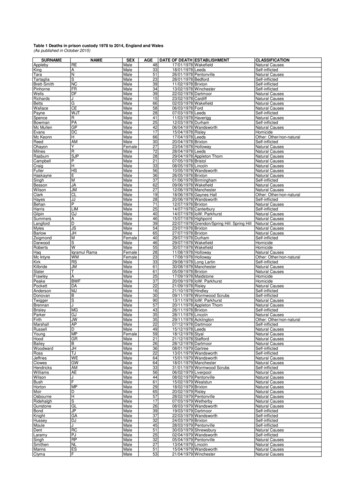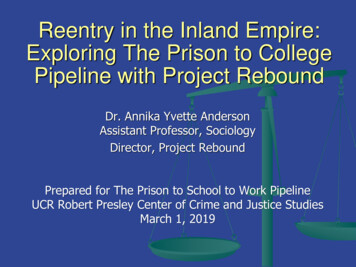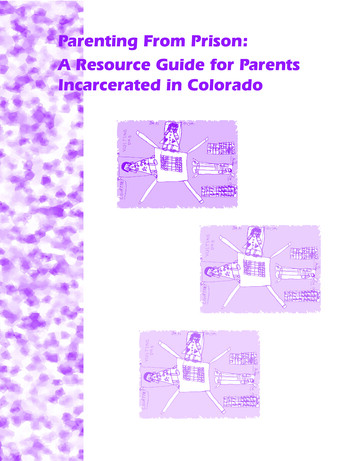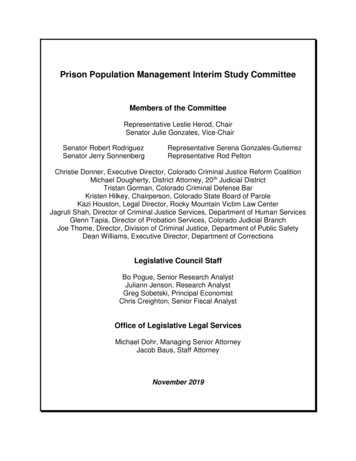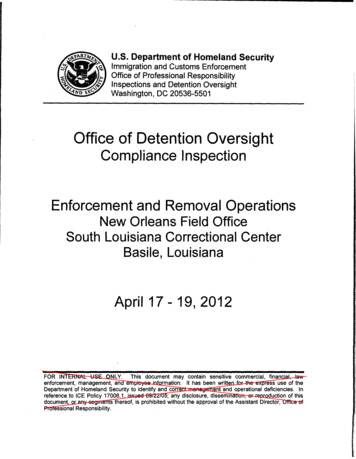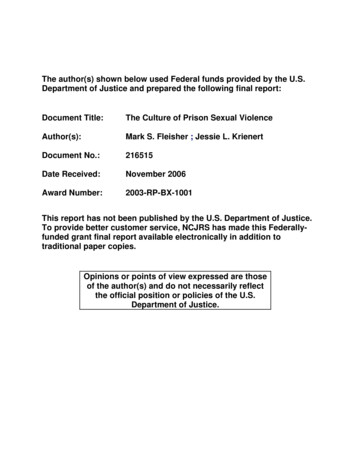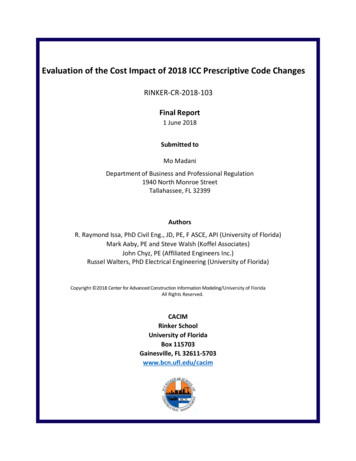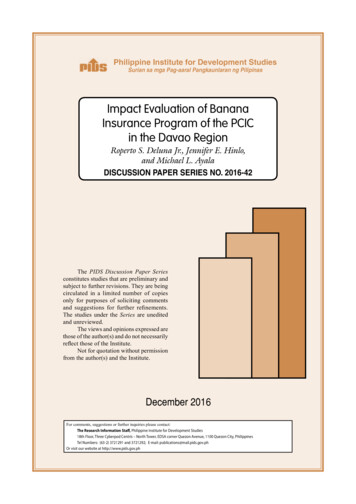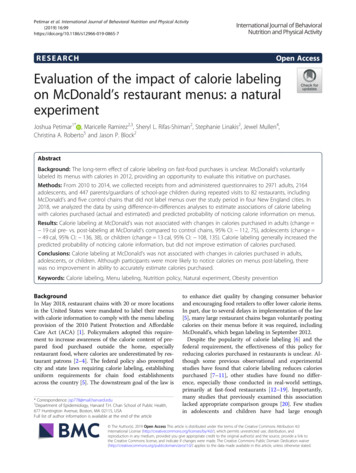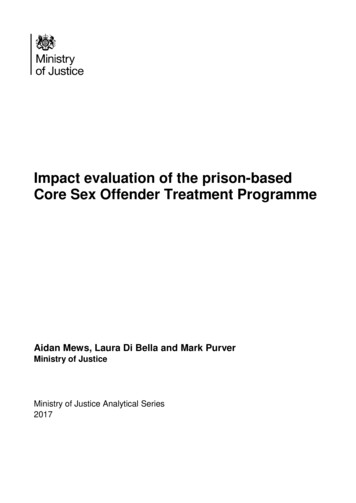
Transcription
Impact evaluation of the prison-basedCore Sex Offender Treatment ProgrammeAidan Mews, Laura Di Bella and Mark PurverMinistry of JusticeMinistry of Justice Analytical Series2017
Analytical Services exists to improve policy making, decision taking and practiceby the Ministry of Justice. It does this by providing robust, timely and relevantdata and advice drawn from research and analysis undertaken by thedepartment’s analysts and by the wider research community.DisclaimerThe views expressed are those of the authors and are not necessarily shared by the Ministryof Justice (nor do they represent Government policy).First published 2017 Crown copyright 2017This publication is licensed under the terms of the Open Government Licence v3.0 exceptwhere otherwise stated. To view this licence, visit /version/3 or write to the Information Policy Team, The National Archives,Kew, London TW9 4DU, or email: psi@nationalarchives.gsi.gov.uk.Where we have identified any third party copyright information you will need to obtainpermission from the copyright holders concerned.Any enquiries regarding this publication should be sent to us atmojanalyticalservices@justice.gsi.gov.ukThis publication is available for download at www.gov.uk/government/publicationsISBN 978-1-84099-783-5
AcknowledgementsFrom the Ministry of Justice the authors would like to thank Imran Ejaz, Kathryn Hopkins andMichael Cohen for their significant contributions to this project, and John Marais and OsamaRahman for their oversight.The authors would also like to thank an external advisory panel comprising of Conor Duggan,Friedrich Lӧsel, Karl Hanson, Lorraine Dearden, Mike Daly, Paul Ainsworth and RichardDorsett. Thanks are also due to Gerald Gaes and Martin Schmucker for their comments onthe report.
ContentsList of tablesList of figuresSummary1Aims and background1Key findings3Conclusions4Background6Research question6The England and Wales Sex Offender Treatment Programme6Efficacy of treatment for sex offenders – UK and international evidence8Approach10Criteria for inclusion in the study10Offence categorisation11Limitations12Results15Overall findings15Reoffending rates over time16Sensitivity analyses18Quantifying bias: sensitivity of the results to unobserved factors23Conclusions26References29Technical Annex33Annex AThe data setAnnex BSample descriptionAnnex CPropensity score matching (PSM)Annex DOutcome MeasuresAnnex EAdditional survival analysis33333535393952525757
List of tablesTable A.1: Breakdown of index offences by category (unmatched groups)35Table A.2: Breakdown by sentence length (unmatched groups)35Table A.3: RM2000/S score distribution (unmatched groups)36Table A.4: Overall and 2-year binary reoffending rates (unmatched groups)38Table A.5: List of matching factors and matching quality39Table A.6: Parsimonious model, model specification matching quality comparison48Table A.7: Less parsimonious model, model specification matching quality comparison49Table A.8: Overall binary reoffending rates for the matched treatment and comparisongroups using the parsimonious model and the less parsimonious model, with numbersof reoffenders50Table A.9: Overall frequency of reoffending for the matched treatment and comparisongroups using the parsimonious model and the less parsimonious model, with standarddeviations51Table A.10: Sensitivity analyses' results and matching quality on sexual reoffendingbinary and frequency outcomes53Table A.11: Binary reoffending rates and survival analysis for the matched treatmentand comparison groups using 1-5 nearest neighbour matching (treated N 2,493)59List of figuresFigure 1: Sexual reoffending survival curves16Figure 2: Child image reoffending survival curves17Figure 3: Sexual reoffending survival curves, with comparison observations censoredat the point of treatment19Figure A.1: Distribution of the logit of the propensity scores across the treatment andcomparison groups, before and after matching46Figure A.2: Time from reoffence to reconviction for different types of offences52
SummaryAims and backgroundThe aim of the research was to extend the evidence base on the effectiveness of treatmentfor sexual offenders. This study measures the impact of the prison-based Core Sex OffenderTreatment Programme (SOTP) on the re-offending outcomes of sex offenders in Englandand Wales, whilst controlling for the different observable characteristics, needs, and riskfactors of offenders.Core1 SOTP is a cognitive-behavioural psychological intervention designed by the HM Prisonand Probation Service (HMPPS) for imprisoned men who have committed sexual offences.The Programme is intended to reduce sexual reoffending amongst participants by identifyingand addressing known criminogenic needs. It was accredited for use in prisons in 1992 bythe then HM Prison and Probation Service Prison and Probation Services Joint AccreditationPanel, which later became the Correctional Services Accreditation and Advice Panel(CSAAP).2 The CSAAP help the MOJ and HMPPS to develop and implement high qualityoffending behaviour programmes and promote excellence in programmes designed toreduce reoffending. Programmes are assessed against a set of criteria derived from the“what works” evidence base. These include having a clear model of change, effective riskmanagement, targeting offending behaviour, employing effective methods, ensuringrelevance to individual learning styles, and maintaining the quality and integrity of delivery.Changes have been made to the targets, the content, and the methods used in Core SOTPsince its introduction in response to emerging research. As a result, during the course of thisstudy (and in the period thereafter) the Programme has changed. However, it remains acognitive behavioural group based treatment approach. It was, and remains, available inapproximately one-sixth of male prison establishments in England and Wales and is intendedfor individuals sentenced to 12 months or more, who had either a current or previous(sentence) sex offence, were willing to engage in treatment, and were not in denial of theiroffending.There were 2,562 convicted sex offenders who started treatment under the prison-basedCore Sex Offender Treatment Programme between 2000 and 2012 in England and Wales.These were matched to 13,219 comparison sex offenders using 87 matching factors from12Other variants of the Programme also exist, including the Adapted Programme for lower IQ prisoners, and theExtended Programme for higher risk offenders.CSAAP is a non-statutory advisory body for HMPPS. It provides independent expert advice on effectivecorrections for the Ministry of Justice and HMPPS.1
Police National Computer (PNC) records, SOTP treatment records, and the OffenderAssessment System (OASys) database (where available). Standardised mean differencesbetween the matched treated and comparison groups for the matching factors showed thatthe matching quality achieved was excellent.Propensity score matching (PSM) was used to match sexual offenders who participated inCore SOTP (treated sex offenders) to similar sexual offenders who did not.3 PSM is astatistical matching technique which uses factors theoretically and empirically associatedwith both receiving the treatment and the outcome variable (i.e. reoffending) to predict a‘propensity score’, which represents the likelihood of entering treatment. This propensityscore is then used to match treated individuals to comparison offenders who are similar tothem.The matched treatment and comparison groups were then compared on an extensive rangeof proven reoffending outcomes (sexual and non-sexual). These outcome measures werecalculated over a period of up to 13.9 years (average of 8.2 years) starting from eachoffender’s release from prison between 2002 and 2012, with the follow-up period finishing inOctober 2015. For all individuals in this study (the treatment group plus the unmatchedcomparison group), the binary reoffending rate for all offences was 38.3% and the sexualreoffending rate excluding breaches,4 was 7.5%. These are low when compared tointernational studies but are within the range of other UK-based studies on reconviction ratesfor sex offenders (Craig et al., 2008).PSM can provide a robust quasi-experimental approach, although offenders can only bematched on observable variables. While extensive efforts were undertaken in identifyingrelevant factors, it is possible that unobserved factors could influence the findings thatemerge from this research. Such factors include deviant sexual interest, general selfregulation problems and the degree of violence associated with the current sexual offence.34A suitable comparison group of sex offenders who did not participate in Core SOTP could be formed becausemany were in prisons where Core SOTP was not run, while others were in prisons where the programme wasrun but could not participate due to a shortage of places.Breaches are non-compliance against the conditions of an offender’s release from prison or the requirementsplaced on them whilst serving a sentence in the community.2
Key findingsThe main findings of the analysis were as follows: Some statistically significant differences were detected over an average 8.2 yearfollow up period. They were small in magnitude although they widened over thefollow-up period. In particular: More treated sex offenders committed at least one sexual reoffence(excluding breach) during the follow-up period when compared with thematched comparison offenders (10.0% compared with 8.0%). More treated sex offenders committed at least one child image reoffenceduring the follow-up period when compared with the matched comparisonoffenders (4.4% compared with 2.9 %).Otherwise, the matched treated and comparison groups had similar reoffendingrates across a variety of outcome measures. A variety of sensitivity analyses were performed, which mostly focused on thesexual reoffending measure. The sexual reoffending treatment effect was foundto be reasonably stable across these.As previously noted, it is possible that these results could be materially influenced byunobserved factors. However, such factors would need to increase both the odds oftreatment and the odds of reoffending after controlling for the observable factors that wereincluded within the matching process. In fact to conclude that the sexual re-offendingtreatment impact is not statistically significantly different from a reduction of 2 percentagepoints, the odds of treatment and re-offending would both need to increase by 122%. Thisincreases to 219% for a 5 percentage point reduction. While the sensitivity analysis, involvingboth treatment and comparison groups, shows reoffending rates to be higher for individualswho have higher risk profiles, the matching process includes a range of factors that are usedto determine risk.3
ConclusionsThe results suggest that while Core SOTP in prisons is generally associated with little or nochanges in sexual and non-sexual reoffending, there were some statistically significantdifferences. The small changes in the sexual reoffending rate suggest that either Core SOTPdoes not reduce sexual reoffending as it intends to do, or that the true impact of theProgramme was not detected.This study draws on large treatment and comparison groups, long follow-ups, and manymatching factors, thus addressing the most common shortcomings in the research field onsex offenders' reoffending behaviour. However it still has a number of limitations that couldeither bias the findings or the interpretation of them. In particular: It is impossible to conclusively rule out the absence of variables relating todeviant sexual interest,5 general self-regulation problems and the degree ofviolence associated with the current sexual offence that could possibly influencethe results. Moreover, it is possible that the available data do not fully account forissues such as motivation to address offending behaviour. However, theseabsences are at least partly accounted for by matching factors included in thisstudy (e.g. sexual deviancy by matching factors covering previous offending).Furthermore as shown above, what remains unaccounted for would need to havestrong relationships both with participation onto treatment and reoffending toconclude that Core SOTP is associated with a reduction in sexual reoffending. The estimated impact of Core SOTP was found to be similar when removing fromthe comparison group those who were identified as having done communitySOTP. However, it will include some differences between the matched treatmentand comparison groups that reflect changes occurring after the prison sentencehas commenced and which are not associated with the provision of Core SOTP.Such factors include participation on other treatment programmes in prison andin the community, differences in offender management and in supervision, andregional demographics e.g. in employment rates. Availability of good quality data on all factors which determine an offenders’participation on core SOTP, was also a particular issue. It is possible that paucityof data on some key offender characteristics including denial of offending, and adegree of self-selection, could bias the results.5This can be defined by grouping together factors relating to sexual preoccupation, sexual preference forprepubescent or pubescent children, sexualised violence and multiple paraphilias (Mann, Hanson & Thornton,2010).4
One of the main issues that will need to be addressed in any future studies on theeffectiveness of SOTP in prisons, using some form of matching approach, is the collection ofinformation on all potentially important variables. The lack of comprehensive empirical dataon deviancy is a major issue that needs further investigation. Additional factors that needincorporating into any future study include other interventions received in prison and in thecommunity, and the
Impact evaluation of the prison-based Core Sex Offender Treatment Programme . Aidan Mews, Laura Di Bella and Mark Purver . Ministry of Justice . Ministry of Justice Analytical Series . 2017 . Analytical Services exists to improve policy making, decision taking and practice by the Ministry of Justice. It does this by providing robust, timely and relevant data and advice drawn from research and .
